Reviews
Jul 7, 2019

Guardians of Aotearoa: Protecting New Zealand’s Legacies
Nā Johanna Knox, with photography by Jess Charlton
Bateman Books 2018
RRP: $59.99
Review nā Freya Helen Wharerimu Hargreaves-Brown
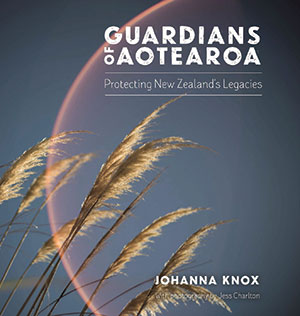 Whiria te tāngata — Weave the people together.
Whiria te tāngata — Weave the people together.
Guardians of Aotearoa does just this, crafting a korowai of diverse narratives. From activists, to ecologists, to te reo Māori advocates, Knox shines a light on the people who call this place home, and their passions.
The work views the world through a holistic lens. Knox begins by reflecting on how her initial focus was intended to be the environmental realm. However, this was soon abandoned, with the author writing: “How do you divorce the natural environment from people and culture? We’re part of a whole.” This approach is to be commended, as it allows for a variety of “guardians” to be heard, and their stories shared.
If we are to resolve many of the environmental, political, and social issues of our time, it will only be through listening to one another and collaborating.
Guardians of Aotearoa highlights this, and is a testament to the necessity of a broad range of perspectives in order to combat challenges and inequalities. The 39 interviews in this book are inspiring and rousing. Although it is attractive, this is more than just a “”coffee-table” book, and gives real and valuable insight into the worlds of our country’s change-makers. From freshwater ecologist Dr Mike Joy advocating for our rivers, to writer and illustrator Gavin Bishop preserving our art, to Dr Hana O’Regan revitalising te reo Māori – all are thought-provoking.
Knox’s book thus speaks of the power of the individual; but also symbolises the potential for change when a collective comes together. It challenges the reader to reflect upon their own experiences and to ask: “What would I like to do, and how may I achieve that?”
Compassion and the need for collaboration run as undercurrents throughout the work; significant values within te ao Māori. It serves as a reminder for us all to come home to this intrinsic Māori worldview; one that sometimes appears to be lost amongst the hurry of modern life. As interviewee Tina Ngata proclaims, “Regardless of whether I win or lose, this is about the values I carry for the time that I’m here … I want to be a good ancestor.”
Johanna Knox’s interviews, paired with Jess Charlton’s intimate and visually beautiful portraits, offer a glimpse into the diversity of the people and ideas that stand here. Captivating and inspiring, Knox has woven a korowai of knowledge to be laid upon this land and our people.
 Freya Helen Wharerimu Hargreaves-Brown (Ngāi Tahu, Awarua) was born in Charteris Bay, and is currently studying towards a Bachelor of Arts majoring in Māori and Indigenous Studies at Te Whare Wānanga o Waitaha (University of Canterbury). After volunteering in rural Fiji for several months in 2018, she is planning to work with Māori and Pasifika communities on improving health and environmental outcomes in the future.
Freya Helen Wharerimu Hargreaves-Brown (Ngāi Tahu, Awarua) was born in Charteris Bay, and is currently studying towards a Bachelor of Arts majoring in Māori and Indigenous Studies at Te Whare Wānanga o Waitaha (University of Canterbury). After volunteering in rural Fiji for several months in 2018, she is planning to work with Māori and Pasifika communities on improving health and environmental outcomes in the future.
Kaitiaki o te Pō – Essays
Nā John-Paul Powley
Seraph Press 2019
RRP: $35.00
Review nā Gerry Te Kapa Coates
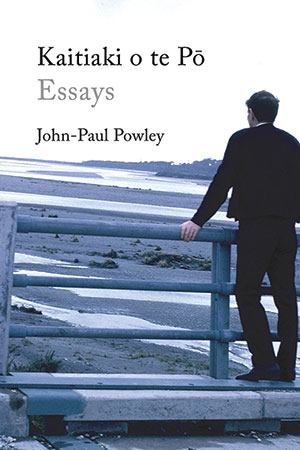 A collection of personal essays is always a risky undertaking, sharing one’s innermost thoughts with the world – or at least the reading world. Some Kiwi writers have struck it lucky though, like Ashleigh Young’s prize-winning essay collection Can You Tolerate This? in 2016. The cover of this pukapuka gives little away about John-Paul, but through the stories and poems we learn that he is – or was – a teacher in a school with Māori pupils, and became a class Dean dealing with functional and dysfunctional kids, working as a cog in the education machine. He also has a fine sensitivity for Māori issues and racism. He was in a band once, and sometimes wishes he was back there.
A collection of personal essays is always a risky undertaking, sharing one’s innermost thoughts with the world – or at least the reading world. Some Kiwi writers have struck it lucky though, like Ashleigh Young’s prize-winning essay collection Can You Tolerate This? in 2016. The cover of this pukapuka gives little away about John-Paul, but through the stories and poems we learn that he is – or was – a teacher in a school with Māori pupils, and became a class Dean dealing with functional and dysfunctional kids, working as a cog in the education machine. He also has a fine sensitivity for Māori issues and racism. He was in a band once, and sometimes wishes he was back there.
The title of the book – and of the first story – comes from Justice Joe Williams, who described the role of a historian as a “kaitiaki o te pō” – caretaker of the night. John-Paul says, “It’s funny how I forget the power of stories.” Then he proceeds to tell us stories about life in Aotearoa drawn from his personal experiences – starting with a history conference. The death of an old friend in London leads him on to musings about the impact of war, and memories of his male relatives who were either severely damaged by World War One or died in World War Two. He quotes Tāwhiao saying to Te Whiti after the Pākehā colonists won the Waikato war, that now “I will … eat tears of bitterness from sunrise to sunrise” – a fitting end to this story. The story “Anzac Day” is a riff about the myths we (especially young men and boys) grew up with about war: that New Zealand “lost its innocence at Gallipoli”, the soldiers “nobly sacrificed their lives in war”, etc, etc. I remember the mother of a friend in the 50s asking me if I’d go off to war, and I cravenly said yes, despite knowing I probably wouldn’t.
John-Paul says when he was young he spent a lot of time by himself watching his mum’s video cassettes of things like Kenneth Clark’s 1960s TV series Civilisation, that decades later would inspire him to go to Florence and Chartres Cathedral. He muses about how men seem to fall into two categories – business men and construction workers, which never seem to notice each other. They have “mastered the machinery of being a well-oiled cog in the large machine of masculinity: a machine I detest.” “Digital Natives” looks at the Parihaka story and education conferences: “Wasn’t it good to see so many speakers began their presentations with Māori? Of course a lot of them didn’t pronounce it very well and some were clearly making noises they didn’t understand. One hundred and seventy-seven years after the Treaty, that’s a good effort, right? A little bit of brown sugar on the pile of white bread.”
The story “The March of Progress” revolves around nature, the four seasons and a school trip to Japan. Powley concludes presciently: “We always think things are going to get better. They ain’t. Not anymore.” He quotes others’ poetry from time to time, and includes some creditable poems of his own. He asks a lot of questions which sometimes he answers, or else leaves us to muse over later.
He does another trip – bravely chaperoning 20 young women to India – to experience a gruelling exposure to India’s poverty, giving us at the end his conclusions about the “dignity of man”: “What I knew deepest down, remained true: death is final, existence is indifferent, so much depends on having or not having power, and love is the only thing.” This book deserves to be up there with the best in the genre. John-Paul may not be by a Māori writer, but he is certainly an excellent essayist and one with a Māori heart.
 Gerry Te Kapa Coates (Ngāi Tahu, Waihao) was born in Ōāmaru, and has had poems, book, and theatre reviews and stories in Huia Short Stories collections 4, 5, and 7; and other publications including Landfall, Mana magazine and Ora Nui 3, as well as a wide variety of non-fiction espousing environmental issues, amongst other themes. His collection of poems and short stories from 1961–2011, The View From Up There, was published by Steele Roberts. Gerry was a panellist at the 2013 Christchurch Writers and Readers Festival. He also works as a consultant and commissioner on RMA and similar EPA hearings, as well as being an author and doing Māori and technology advisory work.
Gerry Te Kapa Coates (Ngāi Tahu, Waihao) was born in Ōāmaru, and has had poems, book, and theatre reviews and stories in Huia Short Stories collections 4, 5, and 7; and other publications including Landfall, Mana magazine and Ora Nui 3, as well as a wide variety of non-fiction espousing environmental issues, amongst other themes. His collection of poems and short stories from 1961–2011, The View From Up There, was published by Steele Roberts. Gerry was a panellist at the 2013 Christchurch Writers and Readers Festival. He also works as a consultant and commissioner on RMA and similar EPA hearings, as well as being an author and doing Māori and technology advisory work.
Ake Ake Kia Kaha E! Forever Brave: B Company
28th Māori Battalion 1939–1945
Nā Wira Gardiner
David Bateman 2019
RRP: $49.99
Review nā Russell Caldwell
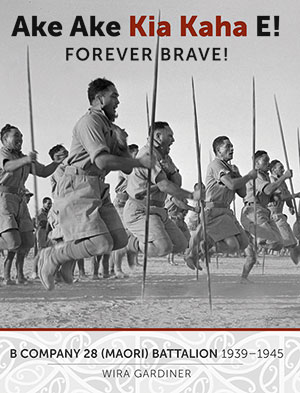 The 28th Māori Battalion was the most decorated New Zealand fighting unit during World War II. Its formidable prowess in battle was acknowledged by Allied forces and German commanders alike. The Māori Battalion was a frontline infantry unit made up entirely of volunteers from Māori communities throughout the country. It was organised on tribal lines under tribal leaders. Ake Ake Kia Kaha E! Forever Brave breaks new ground in providing a comprehensive account of B Company 28th Māori Battalion’s significant contribution to the war. B Company drew its members mainly from Te Arawa and Mātaatua confederations of tribes, but also from Tauranga Moana, Coromandel, Taupō, Waikato, and King Country.
The 28th Māori Battalion was the most decorated New Zealand fighting unit during World War II. Its formidable prowess in battle was acknowledged by Allied forces and German commanders alike. The Māori Battalion was a frontline infantry unit made up entirely of volunteers from Māori communities throughout the country. It was organised on tribal lines under tribal leaders. Ake Ake Kia Kaha E! Forever Brave breaks new ground in providing a comprehensive account of B Company 28th Māori Battalion’s significant contribution to the war. B Company drew its members mainly from Te Arawa and Mātaatua confederations of tribes, but also from Tauranga Moana, Coromandel, Taupō, Waikato, and King Country.
This work can be read at different levels. On one level the book is a definitive military history. The detailed narrative sustains the reader from the prologue to the conclusion. The book also features exclusive images, tactical maps, and clear accounts of the battles and the significant campaigns in Greece, North Africa, and Italy. On another level, the book is a taonga detailing the stories of the men and their whānau who sacrificed so much. It connects the past with those who live now. It is on that personal level that I read the book. Two of my
Ngāi Tahu/Te Arawa kaumātua, Uncle Andrew Gourlay and Uncle Thomas Potiki, fought overseas in the ranks of B Company alongside their cousins and close Te Arawa relations the Rollestons, O’Briens and Tapsells from Maketū.
This is an important work because of the material and expert knowledge on which it draws. The text is complemented with the observations and stories of the men themselves through the inclusion of their letters, family kōrero, and photographs. This material is intertwined with the expert commentary and analysis of the book’s author, Lieutenant-Colonel (Rtd) Sir Harawira (Wira) Tiri Gardiner KNZM, writer, senior public servant, and a former professional soldier who saw active service in South Vietnam. This book by Sir Wira builds on the general military history of the 28th Māori battalion that he wrote in 1992. Sir Wira is of Ngāti Awa, Ngāti Pikiao, Whakatōhea, and Te Whānau a Apanui descent. This is integral to the quality of the narrative, as it has allowed for the positioning and contextualising of wartime relationships between people, whānau, and their experience of war from a uniquely tribal perspective. Sir Wira has done a fine job of commemorating the honour, selflessness, and undoubted bravery of B Company. At the same time, he deals frankly and honestly with the ongoing physical and psychological impacts of war, and he acknowledges those whānau left at home who suffered extensively from stress, anxiety, and grief.
The book does not restrict itself to bravery on the battlefield. It also illuminates the role of women who stayed back and kept things going at home, and the experiences of many servicemen on their return to Aotearoa. The personal highlight of the book for me is the list of the 968 soldiers who served overseas with B Company, along with photographs. Ake Ake Kia Kaha E! makes an important contribution to our knowledge about Māori in international conflicts and the growing desire for such knowledge to be distinctively grounded in the Māori world, and told with Māori voices, with cultural cognition by tribal historians. Kaumātua Robert Gillies, the last remaining soldier of B Company, was the kaitiaki who guided and supervised the production of this work. This will become a treasured publication that will help us move forward into the future, recognising and remembering B Company 28th Māori Battalion, their profound service, and their enduring legacy. Ake Ake Kia Kaha E! is a great read. Ka maumahara tonu tātou ki a rātou – We will remember them. Onward.
 Russell Caldwell (Ngāi Tahu/Te Arawa) manages a youth justice facility in Christchurch. He has worked in a number of senior roles in government and Māori organisations, including 10 years with the Ngāi Tahu Māori Trust Board and Te Rūnanga o Ngāi Tahu. He has previously served as an infantryman and signaller in Ngāti Tumatauenga, the New Zealand Army; a second lieutenant in Te Taua Tauira o Aotearoa, the New Zealand Cadet Forces; and a specialist service officer in the Australian Army Cadets, Northern Territory Battalion. Russell holds a degree in New Zealand History and a Master’s degree in Business. He has published works on the New Zealand Wars and Ngāi Tahu whakapapa, and extensively researched the involvement of his own whānau in the Māori Battalion.
Russell Caldwell (Ngāi Tahu/Te Arawa) manages a youth justice facility in Christchurch. He has worked in a number of senior roles in government and Māori organisations, including 10 years with the Ngāi Tahu Māori Trust Board and Te Rūnanga o Ngāi Tahu. He has previously served as an infantryman and signaller in Ngāti Tumatauenga, the New Zealand Army; a second lieutenant in Te Taua Tauira o Aotearoa, the New Zealand Cadet Forces; and a specialist service officer in the Australian Army Cadets, Northern Territory Battalion. Russell holds a degree in New Zealand History and a Master’s degree in Business. He has published works on the New Zealand Wars and Ngāi Tahu whakapapa, and extensively researched the involvement of his own whānau in the Māori Battalion.
Te Ahi Kā: The Fires of Occupation
Nā Martin Toft
Dewi Lewis Publishing 2018
Distributed in New Zealand by Oratia Books
RRP: $65.00
Review nā Gerry Te Kapa Coates
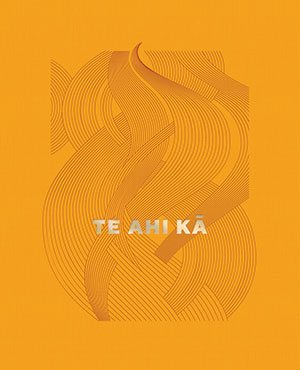 This is a very beautiful hardback book with 76 black and white and colour photographs interspersed with several groups of fold out pages of text about the Whanganui river – Te Awa Tupua. For the first time in Aotearoa – and possibly the world – a river has been granted the same legal rights as a human being, entrenching traditional rights of the iwi along the river. This work breathes new life into the whakataukī: Ko au te awa, ko te awa ko au – I am the river, the river is me.
This is a very beautiful hardback book with 76 black and white and colour photographs interspersed with several groups of fold out pages of text about the Whanganui river – Te Awa Tupua. For the first time in Aotearoa – and possibly the world – a river has been granted the same legal rights as a human being, entrenching traditional rights of the iwi along the river. This work breathes new life into the whakataukī: Ko au te awa, ko te awa ko au – I am the river, the river is me.
By the end of this book you will know more about the river from the magnificent and diverse photographs, as well as what its people look like and say, and how they live. Danish author and photographer Martin Toft first spent time living with Māori from the Whanganui river in the mid-1990s, and returned 20 years later to assemble the photographs in the book. You will not learn much about the process that led to the Te Awa Tupua (Whanganui River Claims Settlement Act 2017), but you will get a sense of what it meant to local Māori. As the book’s publicity leaflet says, this work “evokes the physical and metaphysical relationship between a river and its ancestors, between Māori and the author”, who was honoured by being given the Māori name of Pouma Pōkai-whenua. You will be immersed in this world through letters, conversations, snippets of poetry, and other explanations.
Te Ahi Kā literally means “fires of occupation”, and fire represents a life principle for Māori. Only on their land can Māori “put up our ancestral houses that shelter the mauri – the life-force of us people.” The book is partly about a hīkoi from the kāinga or settlement at Tieke further downstream on the Whanganui River, back up to ancestral land at Mangapapapa to assert their ahi kā – by staying at least one night there – and prevent it being taken over by the Department of Conservation. The author – as Pouma – appears as an interviewer in some of the transcribed pieces of writing with various people of the Whanganui river – Mark Cribb, Hokio, Tawhero, Paiki Johnson, Larry Ponga, and Tukaiora, amongst others. In one piece Pouma asks Tawhero why he was given a Māori name, and Tawhero tells him it was the name of one of their great explorers, “synonymous with journeys up and down the river … We asked you to “always support us, always umbrella us … and now you are sheltering us … One of the things that is important for you to know is that you are part of our family.”
Talking about genealogy, Hokio says: “We are all from both the North Island and South Island interconnected. Because that is whakapapa – genealogy.” Later he says: “To whakapapa about a particular area in the river is to whakapapa about the connection of the awa to everywhere else.” This principle is quoted from the Whanganui River Settlement: “The health and wellbeing of one element of the River is intrinsically connected to the health and wellbeing of the whole River, its mauri and its mana.”
On the future of the remote Mangapapapa Marae, accessible only by boat, Tawhero says: “What I would like to see – and what I’m hoping to be able to set up for our kids – is giving our young people an understanding of the river and what it means to us and to them. But also to build, not so much the fires of occupation, but also the fires of ambition.”
I have spent many visits on the Whanganui river, including a New Year’s Eve at Titi Tihu’s kāinga and in the rohe that feeds the awa – the area that diverted water from the Whanganui River to the Tongariro Power Scheme back in the 1970s. This book will provide memories for those who have had similar experiences, and the photographs will provoke questions that captions might have answered. Such lacks don’t detract from the beauty of the book production itself.
The Girls in the Kapa Haka
Nā Angie Belcher rāua ko Debbie Tipuna
Picture Puffin 2019
RRP: $17.99
Review nā Allanah Burgess
rāua ko Kaia Waaka (4)
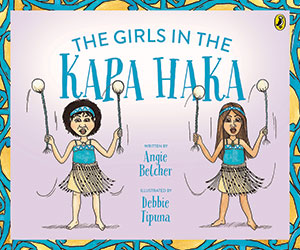 Reading to my tamariki Kaia (4) and Maika (2) is very important to me. I am always on the lookout for new pukapuka to share with them, particularly those with stories that are relatable to our lives and our learning journey in te reo Māori.
Reading to my tamariki Kaia (4) and Maika (2) is very important to me. I am always on the lookout for new pukapuka to share with them, particularly those with stories that are relatable to our lives and our learning journey in te reo Māori.
The Girls in the Kapa Haka ticked all those boxes for me. It was easy to read, with the perfect amount of te reo for my tamariki to understand. The story itself is repetitive so it gave Kaia a chance to learn the words and finish off the sentences with me.
The illustrations are lovely, and they were great for Kaia because she could use them to tell the story herself. For example, she commented that the pictures showed the piuipiu making the “swishing” sound mentioned in the story.
The illustrations provide talking points and extend the story beyond just the words. Kaia really liked the small details. A couple of things she pointed out were the nani’s beautiful necklace, and the taniwha doing the pūkana at the marae.
When I asked Kaia what she thought of this pukapuka, she said that she liked the koro in the story who cut the harakeke for the nani, because that reminded her of her own koro. She enjoyed the fact that there were some words that she knew, and loved seeing the illustrations of the girls with their poi just like her own one that she can swing.
But mostly she liked the whānau all together at the end, and said that it was a very nice story and that she felt happy to read it, because sometimes kapa haka is too loud for her ears!
It was great to see the glossary at the back with helpful hints for correct pronunciation – not just a wonderful book but a fantastic resource for basic language learners.
When I asked Kaia how many stars she would give this book she replied, “Five! Five is a good number.”
 Allanah Burgess (Ngāi Tahu, Te Ātiawa) is a project advisor for Whakapapa Ngāi Tahu and a proud māmā to her two tamariki Kaia (4) and Maika (2) Waaka. They live in Ōtautahi but call Waikawa ki Te Au Ihu home. Kaia is a creative kōtiro who has a love for pukapuka, art and role play. She loves spending holidays with her whānau in Waikawa, especially visiting her Nani, Koro and many cousins.
Allanah Burgess (Ngāi Tahu, Te Ātiawa) is a project advisor for Whakapapa Ngāi Tahu and a proud māmā to her two tamariki Kaia (4) and Maika (2) Waaka. They live in Ōtautahi but call Waikawa ki Te Au Ihu home. Kaia is a creative kōtiro who has a love for pukapuka, art and role play. She loves spending holidays with her whānau in Waikawa, especially visiting her Nani, Koro and many cousins.
Opinions expressed in REVIEWS are those of the writers and are not necessarily endorsed by Te Rūnanga o Ngāi Tahu.